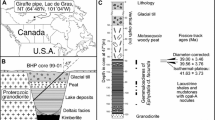Abstract
Hexactinellida differ strongly from other sponges. In recent investigations, their taxonomic status has been raised from a class to the subphylum level (Symplasma; Mackie et al. 1983), or even to that of a distinct phylum (with the same name; Bergquist 1985). They possess remarkable external morphological features and have a syncytial tissue organization. Recent representatives mainly inhabit deep-sea waters.
Access this chapter
Tax calculation will be finalised at checkout
Purchases are for personal use only
Preview
Unable to display preview. Download preview PDF.
Similar content being viewed by others
References
Beklemishev VN (1964) The principles of comparative anatomy of invertebrate animals, vol I. Nauka, Moscow, pp 1–437 (in Russian)
Bergquist PR (1985) Poriferan relationships. In: Conway S, Morris SC, George JD, Gibson R, Piatt HM (eds) The origin and relationships of lower invertebrates, vol 28. Clarenden, Oxford, pp 14–27
Bidder GP (1923) The relation of the form of a sponge to its currents. Q J Microsc Sci 67, NS:293–323
Burton M (1928a) A comparative study of the characteristics of shallow-water and deep-sea sponges, with notes on their external form and reproduction. Q J Microsc Club Lond 16:49–70
Burton M (1928b) Hexactinellida. Danish Ingolf Exp, vol 6, H Hagerup. Copenhagen, pp 1–18
de Laubenfels MW (1955) Archaeocyata and Porifera. In: Treatise on invertebrate paleontology. Geol Soc Am Univ Kansas Press, part E, pp 22–122
Finks RM (1960) Late Paleozoic sponge faunas of the Texas region. Bull Am Mus Nat Hist 120:1–160
Finks RM (1970) The evolution and ecologic history of sponges during Paleozoic times. Symp Zool Soc, vol 25. Academic Press, London, pp 3–22
Heezen BC, Schneider ED (1966) Sediment transport by the Antarctic bottom currents on the Bermuda rise. Nature 211, N 5049:611–612
Ijima I (1901) Studies on the Hexactinellida. Cont. I. (Euplectellidae). J College Sci Tokyo 15:1–299
Ijima L (1903) Studies on the Hexactinellida. Cont 3. (Placosoma, a new euplectellid; Leucopsacacidae and Caulophacidae). J College Sci Tokyo 18:1–124
Ijima I (1904) Studies on the Hexactinellida. Cont 4. (Rossellidae). J College Sci Tokyo 18:1–307
Kirkpatrick R (1908) Description of a new dictionine sponge from the Indian Ocean. Ree Ind Mus Calcutta, 1908–1909 2:21–24
Koltun VM (1967) Hyalospongiae or Hexactinellida from north and far-east seas of the USSR. Nauka, Leningrad, pp 1–124 (in Russian)
Koltun VM (1971) The neotheny in sponges. In: The problems of zoology Leningrad. Proc Zool Inst Acad Sci, pp 43:45 (in Russian)
Mackie GO, Lawn ID, Pa vans de Ceccatty M (1983) Studies on hexactinellid sponges. 2. Excitability, conduction and coordination of responses in Rhabdocalyptus dawsoni (Lambe 1873). Philos Trans R Soc Lond, Ser B 301, N 1107:401–418
McCommon HM (1969) The food of articulate branchiopods. J Paleontol 43, N 4:976–985
Müller WEG, Conrad J, Zahn RK, Steffen R, Uhlenbrock G, Müller J (1964) Cell adhesion molecule in the hexactinellid Aphrocallistes vastus. Species-unspecific aggregation factor. Differentiation 26, N 1:30–35
Okada Y (1928) On the development of a hexactinellid sponge, Farrea sollasii. J Fac Sci Tokyo 4:1–27
Pavans de Ceccatty M (1982) In vitro aggregation of syncitia and cells of a hexactinellid sponge. Dev Comp Immunol 6, N 1:15–22
Raff RA, Kaufman TC (1983) Embryos genes and evolution. The developmental-genetic basis of evolutionary change. Macmillan, New York
Reif WE, Robinson JA (1976) On functional morphology of the skeleton in lichnise sponges. Hexactinellida. Paläontol Z 50, N 1/2:57–69
Reiswig HM (1971) The axial symmetry of sponge spicules and its philogenetic significance. Cah Biol Mar 12, N 4:505–514
Schulze FE (1887) Report on the Hexactinellida. Challenger Rep 21:1–513
Schmalhausen J J (1969) The problems of Darwinism. Nauka, Moscow, pp 1–493 (in Russian)
Thayer CW (1975) Morphologic adaptation of benthic invertebrates to soft substrata. J Mar Res 33, N 2:177–189
Vogel S (1974) Current-induced flow through the sponge, Halichondria. Biol Bull 147:443–456
Zezina ON (1985) The recent brachiopods and the problems of bathyal zone in the ocean. Nauka, Moscow, pp 1–247 (in Russian)
Editor information
Editors and Affiliations
Rights and permissions
Copyright information
© 1991 Springer-Verlag Berlin Heidelberg
About this chapter
Cite this chapter
Tabachnick, K.R. (1991). Adaptation of the Hexactinellid Sponges to Deep-Sea Life. In: Reitner, J., Keupp, H. (eds) Fossil and Recent Sponges. Springer, Berlin, Heidelberg. https://doi.org/10.1007/978-3-642-75656-6_30
Download citation
DOI: https://doi.org/10.1007/978-3-642-75656-6_30
Publisher Name: Springer, Berlin, Heidelberg
Print ISBN: 978-3-642-75658-0
Online ISBN: 978-3-642-75656-6
eBook Packages: Springer Book Archive




